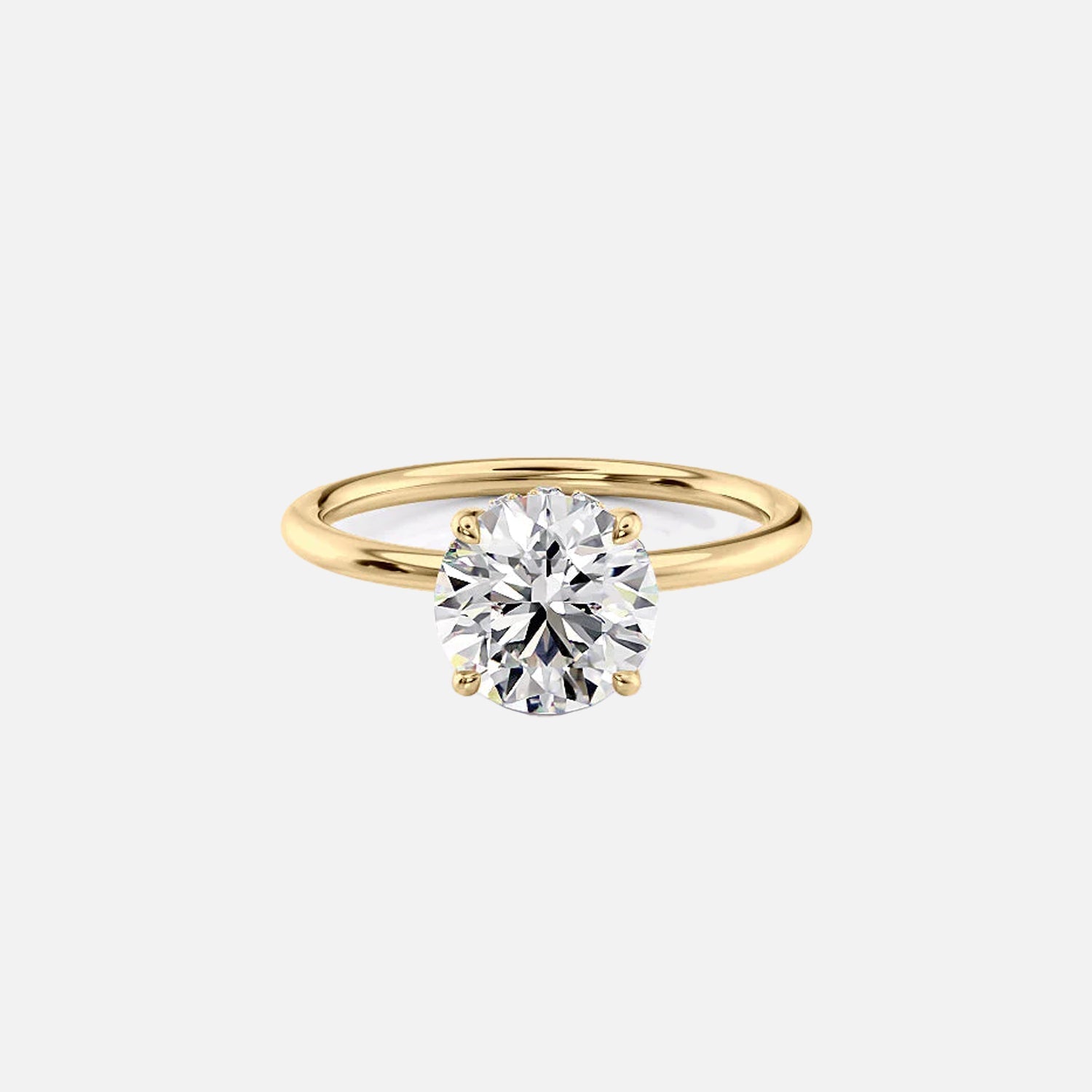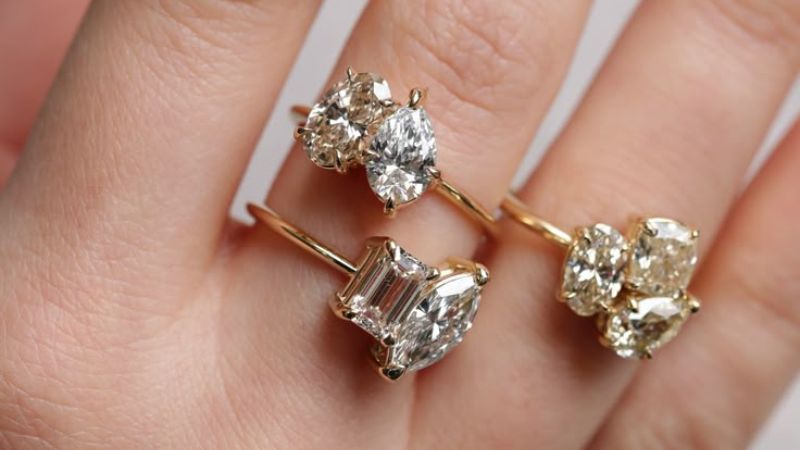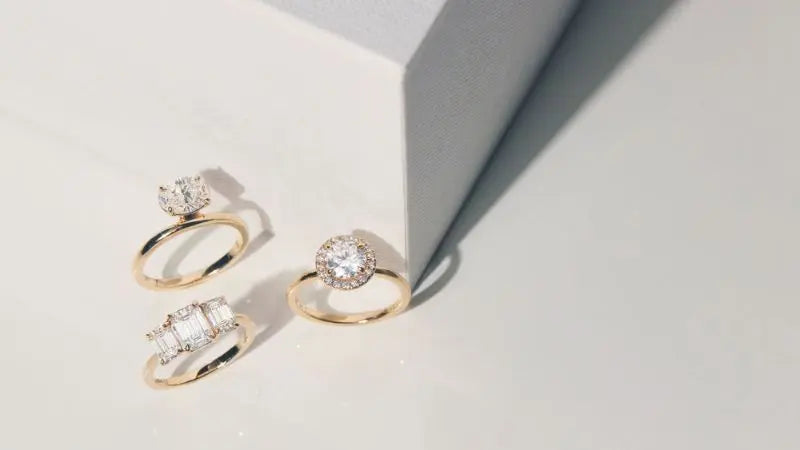Free 30-day Returns | Lifetime Warranty
Free Shipping Worldwide
Both moissanite and diamonds have their strengths, making them exceptional choices depending on your preferences. Moissanite offers dazzling brilliance, affordability, and ethical sourcing, while diamonds provide timeless elegance and cultural significance.
1. Introduction
Choosing the perfect ring can feel overwhelming - especially when the decision comes down to moissanite vs diamond. Both gemstones offer unique qualities, but determining which one fits your style, budget, and values requires a closer look.
In this guide, we’ll compare moissanite vs diamond prices across key factors like cost, brilliance, durability, and ethical considerations. By the end, you’ll know exactly which gemstone is the right choice for your needs.
2. A quick overview of moissanite and diamonds
2.1. Moissanite at a glance
Moissanite is a lab-created gemstone inspired by natural minerals discovered in meteorites. Known for its fiery brilliance and affordability, moissanite has gained popularity as a stunning and ethical alternative to diamonds.
Its unique optical properties make it a standout choice for buyers seeking sparkle without breaking the bank.
2.2. Diamonds at a glance
Diamonds, whether traditionally mined or lab-grown, are celebrated for their timeless elegance and cultural significance.
Formed naturally over billions of years or replicated in advanced labs, diamonds symbolize love, commitment, and luxury. They’ve long been the standard for engagement rings and heirloom jewelry.

Moissanite rings vs diamond
2.3. Quick comparison table

3. Cost of moissanite vs diamond comparison
3.1. Moissanite ring costs
Moissanite rings are widely celebrated for its affordability. A high-quality, 1-carat moissanite ring typically costs between $300 and $800, depending on the cut, color, and setting. Even larger moissanite stones remain cost-effective compared to their diamond counterparts.
3.2. Diamond ring costs
Natural diamonds come with a hefty price tag, with a 1-carat stone ranging from $5,000 to $10,000 or more, depending on quality.
Lab-grown diamonds, while 20–40% cheaper than mined diamonds, still cost significantly more than moissanite. For example, a 1-carat lab-grown diamond might range from $2,000 to $4,000.
3.3. Value proposition
When it comes to value, moissanite offers significant savings without compromising on beauty. For buyers seeking a luxurious yet budget-friendly option, moissanite is an excellent alternative to diamonds.
Moissanite is an excellent alternative to diamonds
4. Brilliance and appearance: What’s the difference?
4.1. Moissanite’s sparkle
One of moissanite’s standout features is its brilliance. With a refractive index of 2.65, moissanite reflects light in a rainbow-like, fiery display that’s unmatched by diamonds.
However, this bold sparkle can appear “flashier” in larger carat sizes, which may not suit everyone’s taste.
4.2. Diamond’s classic glow
Diamonds are prized for their classic white brilliance, with a refractive index of 2.42. Their subtler sparkle is more understated and timeless, making them a favorite for those who prefer elegance over flashiness.
4.3. How they compare in different lighting
Moissanite’s fiery brilliance shines brightest under natural and spotlight conditions, whereas diamonds maintain a sophisticated glow in all lighting environments.
The choice comes down to personal preference: moissanite for bold sparkle or diamonds for subtle radiance.

Moissanite reflects light in a rainbow-like while diamonds maintain a sophisticated glow
5. Durability and long-term wear
5.1. Hardness and scratch resistance
Diamonds are the hardest natural substance, scoring a perfect 10 on the Mohs scale. Moissanite, while slightly softer at 9.25, is still highly resistant to scratches and suitable for daily wear. Both gemstones are excellent choices for engagement rings and wedding bands.
5.2. Toughness and longevity
In terms of toughness, diamonds have a slight edge over moissanite, offering better resistance to chips and cracks over decades of use. However, moissanite remains an exceptionally durable gemstone that will stand the test of time.
5.3. Perfect uses for each stone
- Moissanite: Ideal for engagement rings, wedding bands, and bold statement pieces.
- Diamonds: Best for heirlooms, traditional settings, and those seeking classic luxury.

Durability and long-term wear
6. Ethical and environmental impact
6.1. Moissanite as an ethical gemstone
Moissanite is entirely lab-created, making it conflict-free and environmentally friendly. Its production has a significantly smaller carbon footprint compared to both mined and lab-grown diamonds. For eco-conscious buyers, moissanite is an ideal choice.
6.2. Diamonds: The ethical dilemma
Mined diamonds have long been associated with ethical issues, including conflict diamonds and environmental degradation.
Lab-grown diamonds offer a more sustainable and ethical alternative but still require considerable energy to produce, resulting in a higher carbon footprint than moissanite.
6.3. Why many modern couples are choosing moissanite
With its lower environmental impact and guaranteed ethical sourcing, moissanite appeals to buyers who prioritize sustainability and social responsibility without sacrificing beauty.
7. Which gemstone fits your style?
7.1. For bold and unique sparkle
Choose moissanite if you love a fiery, colorful brilliance that catches the eye. Its bold sparkle makes it perfect for individuals who want their ring to stand out.
7.2. For timeless elegance
Choose diamonds if you prefer a classic, understated look that symbolizes tradition and sophistication. Diamonds are ideal for those who value cultural significance and timeless style.
7.3. Customization options for both
Both moissanite and diamonds can be cut and set in a variety of styles, from modern to vintage designs. Whether you prefer a solitaire, halo, or pave setting, both gemstones offer versatile customization options to suit your taste.
Both moissanite and diamonds can be cut and set in a variety of styles
8. Common myths about moissanite vs diamonds
-
Myth 1: “Moissanite is a fake diamond.”
- Debunk: Moissanite is its own unique gemstone with distinct qualities and beauty.
-
Myth 2: “Moissanite isn’t as durable as diamonds.”
- Debunk: Moissanite is highly durable and perfect for daily wear.
-
Myth 3: “Moissanite looks cheap.”
- Debunk: High-quality moissanite looks luxurious and can even outshine diamonds in certain settings.
9. Pros and cons of moissanite vs diamond rings

10. How to make the right decision
Step 1: Define your budget
Start by determining how much you’re willing to spend. If you’re working with a tighter budget, moissanite is the clear winner, offering stunning beauty at a fraction of the cost. For those who prioritize tradition and luxury, diamonds might justify the higher price tag.
Step 2: Consider your values
Reflect on what matters most to you. If sustainability and ethics are a priority, moissanite is the ideal choice due to its lab-created, conflict-free nature. However, if you want a gemstone steeped in history and tradition, opt for a responsibly sourced or lab-grown diamond.
Step 3: Visualize your style
Think about your dream ring. Do you want a gemstone with bold, fiery brilliance that stands out, or do you prefer a classic, understated look?
Moissanite’s colorful sparkle is perfect for modern, bold designs, while diamonds shine in traditional and vintage-inspired settings.
Step 4: Explore customization options
Both moissanite and diamonds offer flexibility in cuts, settings, and styles. Work with a jeweler to create a ring that reflects your personal taste and vision, ensuring the final piece matches your expectations.
11. Conclusion
Both moissanite and diamonds have their strengths, making them exceptional choices depending on your preferences.
Moissanite offers dazzling brilliance, affordability, and ethical sourcing, while diamonds provide timeless elegance and cultural significance.
By weighing factors like cost, appearance, durability, and values, you can confidently choose the perfect gemstone to symbolize your love and commitment.












